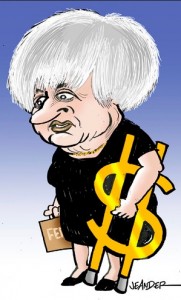Anatole Kaletsky writes: The US Federal Reserve’s decision to delay an increase in interest rates should have come as no surprise to anyone who has been paying attention to Fed Chair Janet Yellen’s comments. The Fed’s decision merely confirmed that it is not indifferent to international financial stress, and that its risk-management approach remains strongly biased in favor of “lower for longer.” So why did the markets and media behave as if the Fed’s action (or, more precisely, inaction) was unexpected?
What really shocked the markets was not the Fed’s decision to maintain zero interest rates for a few more months, but the statement that accompanied it. The Fed revealed that it was entirely unconcerned about the risks of higher inflation and was eager to push unemployment below what most economists regard as its “natural” rate of around 5%.
It is this relationship – between inflation and unemployment – that lies at the heart of all controversies about monetary policy and central banking. And almost all modern economic models, including those used by the Fed, are based on the monetarist theory of interest rates pioneered by Milton Friedman in his 1967 presidential address to the American Economic Association.
Friedman’s theory asserted that inflation would automatically accelerate without limit once unemployment fell below a minimum safe level, which he described as the “natural” unemployment rate. In Friedman’s original work, the natural unemployment rate was a purely theoretical conjecture, founded on an assumption described as “rational expectations,” even though it ran counter to any normal definition of rational behavior.
The theory’s publication at a time of worldwide alarm about double-digit inflation offered central bankers exactly the pretext they needed for desperately unpopular actions. By dramatically increasing interest rates to fight inflation, policymakers broke the power of organized labor, while avoiding blame for the mass unemployment that monetary austerity was bound to produce.
A few years later, Friedman’s “natural” rate was replaced with the less value-laden and more erudite-sounding “non-accelerating inflation rate of unemployment” (NAIRU). But the basic idea was always the same. If monetary policy is used to try to push unemployment below some pre-determined level, inflation will accelerate without limit and destroy jobs. A monetary policy aiming for sub-NAIRU unemployment must therefore be avoided at all costs.
A more extreme version of the theory asserts that there is no lasting tradeoff between inflation and unemployment. All efforts to stimulate job creation or economic growth with easy money will merely boost price growth, offsetting any effect on unemployment. Monetary policy must therefore focus solely on hitting inflation targets, and central bankers should be exonerated of any blame for unemployment.
The monetarist theory that justified narrowing central banks’ responsibilities to inflation targeting had very little empirical backing when Friedman proposed it. Since then, it has been refuted both by political experience and statistical testing. But, despite empirical refutation, the ideological attractiveness of monetarism, supported by the supposed authority of “rational” expectations, proved overwhelming. As a result, the purely inflation-oriented approach to monetary policy gained total dominance in both central banking and academic economics. Inflation Over?

